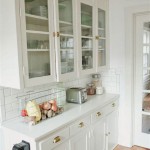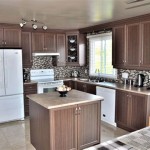Satin Finish Kitchen Cabinets: A Detailed Examination
Kitchen cabinets are a significant investment and a focal point in any kitchen design. The choice of finish plays a crucial role in the overall aesthetics, durability, and maintenance of these cabinets. Among the various cabinet finishes available, satin finish has gained considerable popularity due to its balanced characteristics, offering a subtle sheen that combines elegance with practicality.
Satin finish cabinets are characterized by a smooth, velvety texture with a low-to-moderate sheen. This sheen level is less reflective than high-gloss finishes but more luminous than matte options. The result is a surface that softly diffuses light, creating a warm and inviting atmosphere in the kitchen. The evenness of the sheen also helps to minimize the visibility of imperfections and fingerprints, a key advantage in a high-traffic area like the kitchen.
The process of achieving a satin finish typically involves multiple layers of paint or sealant applied to the cabinet surface. These layers are then buffed or lightly polished to achieve the desired sheen level. The specific materials used and the application techniques can vary depending on the manufacturer and the desired level of durability. Generally, a higher-quality satin finish will involve more intricate processes and result in a more robust and long-lasting surface.
Aesthetic Advantages of Satin Finish Cabinets
One of the primary reasons for the popularity of satin finish cabinets is their aesthetic versatility. The muted sheen complements a wide range of kitchen styles, from traditional to contemporary. Unlike high-gloss finishes which can appear overly modern or stark, or matte finishes which can sometimes look flat or dull, satin finishes strike a balance, providing a sophisticated and refined look that is both timeless and adaptable.
The subtle light reflection of satin finish cabinets can enhance the overall brightness of the kitchen. The light is gently diffused across the surface, minimizing harsh glare and creating a softer, more welcoming ambiance. This can be particularly beneficial in kitchens with limited natural light or those that rely heavily on artificial lighting.
Satin finishes are available in a vast array of colors, further contributing to their design flexibility. Whether consumers desire classic white or off-white cabinets, a bold and vibrant hue, or a natural wood tone, a satin finish can be applied to achieve the desired aesthetic. The finish also tends to render colors accurately, without the color distortion that can sometimes occur with high-gloss or textured finishes.
Furthermore, satin finishes can be effectively paired with a variety of hardware styles and countertop materials. The understated elegance of the finish allows other design elements to take center stage, creating a cohesive and visually appealing kitchen design. From sleek, modern hardware to more ornate, traditional pulls, satin cabinets provide a neutral backdrop that complements a wide range of stylistic choices.
Practical Benefits of Satin Finish Cabinets
Beyond their aesthetic appeal, satin finish cabinets offer several practical advantages that make them a desirable choice for busy kitchens. One of the most significant benefits is their ability to conceal fingerprints, smudges, and other minor imperfections. The low-to-moderate sheen reflects light in a diffused manner, which minimizes the visibility of these marks compared to high-gloss finishes that tend to highlight every imperfection.
This ease of maintenance is a major selling point for satin finish cabinets. While all kitchen cabinets require regular cleaning, satin finishes are generally easier to wipe down and keep looking their best. A damp cloth and mild detergent are typically sufficient to remove most spills and stains. The smooth surface of the finish prevents dirt and grime from becoming deeply ingrained, making cleaning quick and efficient.
Satin finishes also tend to be more durable than some other types of finishes, particularly those with a high-gloss or matte texture. The multiple layers of paint or sealant provide a protective barrier against scratches, chips, and other forms of wear and tear. While no finish is entirely impervious to damage, satin finishes generally hold up well to the rigors of daily use in a busy kitchen environment.
Furthermore, the subtle texture of satin finishes helps to prevent glare, which can be a significant issue with high-gloss cabinets. The diffused light reflection reduces eye strain and creates a more comfortable working environment in the kitchen. This is especially important for individuals who spend a lot of time cooking or preparing meals.
Considerations for Selecting Satin Finish Cabinets
While satin finish cabinets offer numerous benefits, there are also some important considerations to keep in mind when making a selection. The quality of the finish can vary significantly depending on the manufacturer and the materials used. It is essential to choose a reputable manufacturer that uses high-quality paints and sealants and employs skilled craftsmen to apply the finish.
The underlying material of the cabinets is also an important factor to consider. Satin finishes can be applied to a variety of materials, including solid wood, plywood, MDF (medium-density fiberboard), and thermofoil. Each material has its own advantages and disadvantages in terms of durability, cost, and resistance to moisture and warping. Solid wood is generally considered the most durable option, but it is also the most expensive. MDF is a more affordable alternative that provides a smooth surface for painting and is less prone to warping than solid wood.
The color of the cabinets is another important consideration. While satin finishes are available in a wide range of colors, some colors may show dirt and smudges more easily than others. Lighter colors, such as white or off-white, may require more frequent cleaning than darker colors. It is also important to consider how the color of the cabinets will coordinate with other elements in the kitchen, such as the countertops, backsplash, and flooring.
Finally, the type of paint or sealant used to create the satin finish can affect its durability and ease of maintenance. Water-based paints are generally considered more environmentally friendly and easier to clean than oil-based paints. However, oil-based paints may offer greater durability and resistance to scratches and stains. It is important to research the different types of paints and sealants available and choose one that is appropriate for the intended use and maintenance preferences.
In summary, satin finish kitchen cabinets offer a compelling combination of aesthetic appeal and practical benefits. Their versatility, ease of maintenance, and durability make them a popular choice for homeowners seeking a stylish and functional kitchen design. However, it is crucial to carefully consider the quality of the finish, the underlying material of the cabinets, the color selection, and the type of paint or sealant used to ensure that the cabinets will meet the long-term needs and preferences of the user. Selecting high-quality materials and a skilled installer will ensure that the satin finish cabinets provide years of beauty and functionality in the heart of the home.

Satin Vs Semi Gloss And Paint Differences

Glossy Vs Matte Finish Cabinets Which Is Perfect For Your Kitchen

Basics Benefits And Drawbacks Of Matte Cabinet Finishes Awa Kitchen Cabinets

Glossy Vs Matte Finish Cabinets Which Is Perfect For Your Kitchen

Glossy Vs Matte Finish Cabinets Which Is Perfect For Your Kitchen

Choosing The Right Finish For New Kitchen Cabinets Goflatpacks

Gloss Vs Matte Kitchen Cabinets The Pros And Cons

Read This Before Choosing Satin Vs Eggs Paint Blue Kitchen Cabinets Painting Kitchens

Matte Or Glossy Cabinets It S Not Just About Looks Byhyu 112

The Best Paint For Your Cabinets 7 Options Tested In Real Kitchens
Related Posts








